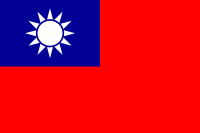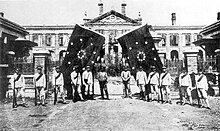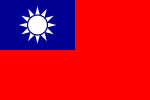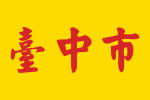Flag of the Republic of China
| Flag of the Republic of China | |
|---|---|
 |
|
| Vexillological symbol : |
|
| Aspect ratio: | 2: 3 |
| Officially accepted: | October 8, 1928 |
The flag of the Republic of China (Taiwan) is red with a white sun on a blue background in the upper left quarter. This part is identical to the party flag of the National People's Party of China (Kuomintang).
symbolism
The three colors symbolize the “ triple popular principle ” according to Sun Yat-sen : Min Chuan ( democracy , blue), Min Sheng ( prosperity , white) and Min Tzu ( nationalism , red).
In the motif of the “blue sky with a white sun” by Lu Hao-tung, the 12 rays of the sun symbolize the 12 months and the 12 traditional Chinese hours (時辰 shíchen), the 2 present-day hours (小時 xĭaoshí, literally: “small shi ") correspond. The "red earth" added to the flag by Sun Yat-sen symbolizes the blood of the revolutionaries who sacrificed themselves to overthrow the Qing Dynasty to found the Republic of China.
The flag became a symbol of the continuity of the ideals of Chinese nationalism. It is also a symbol of the historical and current connection with mainland China .
history

The flag dates from the time of the Chinese Revolution. When the Xinhai Revolution broke out in 1911 , as a result of which the monarchy was abolished and China became a republic, the individual revolutionary armies in the provinces used different flags. The flag of the Wuhan Army had an 18-pointed star with yellow corner points, which should symbolize the then 18 administrative units of China. The Shanghai Army used a flag with the five colors red, yellow, blue, white and black, which represented the five main ethnic groups of China: Han (red), Manchu (yellow), Mongols (blue), Hui (white) , and Tibetans (Black). The flag of the armies of Guangdong , Guangxi , Yunnan, and Guizhou provinces was a white sun on a blue background.
The newly formed Republic of China (1912–1949) , after intensive discussions on February 20, 1912, provisionally and a little later finally, in a kind of compromise, adopted the five-color flag as the state flag, the flag with the yellow stars became the flag of the army and the white sun on a blue background became the flag of the navy. When the second president, Yuan Shikai , proclaimed himself emperor in 1915 , he put a red cross over the other four colors to represent the rule of the Han over the other peoples of China . After his resignation on March 22, 1916, the republic was restored and the five-color flag reintroduced.
Flag of the Empire of China (1915-1916)
Variant with St. Andrew's cross
The white sun on a blue background was designed in 1895 by Lu Hao-tung (陸皓東), an early Chinese revolutionary. Lu had presented his flag design on March 16, 1895 to the Association for the Rebirth of China (興 中 會) in Hong Kong . Later, the Association for the Rebirth of China was incorporated into the Kuomintang, the National People's Party of China, and the flag became the official flag of the Kuomintang. The red background was added by Sun Yat-sen in the winter of 1906 . In 1928, after the reunification of China , the Kuomintang flag became the flag of the Republic of China (1912–1949) .
After the communists' victory in the Chinese civil war , the leadership of the Republic of China established itself on the island of Taiwan (Formosa). The withdrawal was meant to be temporary and the republic initially continued to claim rule over all of China. The flag has remained unchanged to this day.
use
Against the backdrop of Taiwan's unique and controversial political status, another symbolism has evolved over time. The flag is a clear sign that Taiwan is not ruled by the same government as the mainland as it is very different from the flag of the People's Republic of China . The communist government does not recognize the ROC's claim to rule over Taiwan, and the ROC flag is prohibited on the mainland . In contrast, the ban on the flag of the People's Republic of China in Taiwan has been lifted.
The flag of the Republic of China is not ordinarily displayed at international gatherings attended by the People's Republic of China. The flag is also politically controversial in Taiwan. Due to the fact that the flag was previously used all over China, thoughts of the ideologies of Chinese nationalism and Chinese reunification are connected with it.
Although moderate supporters of Taiwan independence (such as former President Chen Shui-bian during his tenure) raise the flag and salute it on official occasions, the flag is never seen at rallies of the Democratic Progressive Party . In contrast, the flag is very conspicuous at rallies of the Pan-Blue coalition . This difference is exacerbated by the colors shown at these gatherings. At rallies of the Pan-Blue Coalition, the colors of the Republic of China flag come to the fore, with a strong predominance of blue and some red. Rallies by parties that advocate independence are adorned with lots of green, but no red or red Blue.
More extreme supporters of Taiwan independence, including ex-President Lee Teng-hui , are calling for the flag to be abandoned. Several alternative designs of a local Taiwanese flag exist. However, the chances of success are not very great. A constitutional amendment is required to change the flag. The current flag has a large crowd of supporters among Pan-Blue supporters and reluctant acceptance among moderate independence supporters.
The raising and lowering of the flag is accompanied by the national flag song .
Service flags
Like the national flag, all service flags have an aspect ratio of 2: 3.
Gösch (historical flag of the Kuomintang )
Flag at sporting events
Since Taiwan is not recognized as an official state by most countries in the world, one competes as Chinese Taipei at sporting events such as the Olympic Games . Another flag is hoisted in this context. Since a resolution of the IOC 1979, the flag of the Taiwanese Olympic Committee is hoisted. This shows the sun of the Kuomintang and the Olympic rings on a white background , framed by two lines in red and blue that form the outlines of a plum blossom. There is also a separate flag for the soccer team.
Flags of Taiwan
- Flags of the provinces and subordinate cities
- Historical flag of Taiwan
Republic of Formosa 1895
- Flag designs of the independence movement
similarities
The flag of the Republic of China (Taiwan) bears some resemblance to the flag of Samoa and, until 2010, the flag of Myanmar . There are no cultural or historical reasons for the flag of Samoa, but the flag of Myanmar may have been designed by the Kuomintang in Burma .
At the 2008 Olympics in Beijing Taiwanese sports fans wanted to wave the flag of Myanmar, as it looks from a distance like the Taiwanese. The reason for this is that Taiwan can only participate in the games as Chinese Taipei under a sports flag and the flag of Taiwan may not be used.
 ? Flag of Myanmar until 2010
? Flag of Myanmar until 2010
See also
Individual evidence
- ↑ a b c Executive Yuan (ed.): The Republic of China Yearbook 2016 . 2016, ISBN 978-986-05-0041-7 , ISSN 1013-0942 (English).
- ↑ 孫文 : 咨 覆 參議 會 論 國旗 文 , 國父 全集 , 第六 冊, pp. 002–003 (Sun Yan-sen: Senate Consultation on the National Flag. In: Complete Works of the Father of the Nation, Volume 7: p . 002-003) text ; Sun Yat-sen did not advocate the top-bottom arrangement of the 5 colors, but the vertical arrangement in order to underline the equality of the nationalities.
- ↑ USAtoday, August 11, 2008, Taiwanese plan to skirt Olympics flag ban






























